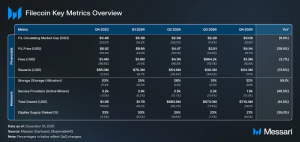Key Insights
- The zkEVM testnet went live with Aave, Uniswap, Lens, and Midnight Society as the first protocols. The testnet is undergoing comprehensive audits and plans for mainnet launch in early 2023.
- Meta selected Polygon as Instagram’s NFT platform. The Meta partnership adds to an existing list of notable partnerships including Adobe, Adidas, Disney, Nike, Reddit, Robinhood, and Starbucks.
- The gaming and NFT sectors saw spikes in activity. The spikes were driven by the continued success of collections and projects like Benji Bananas and Reddit collectibles.
- Polygon Supernets and Polygon zkEVM had multiple notable announcements and partnerships.
Primer on Polygon
Polygon intends to be a general purpose scaling solution for Ethereum. It is actively developing multiple Ethereum scaling solutions including ZK Rollups, Optimistic Rollups, Sidechains, a Data Availability Layer, and a blockchain SDK analogous to the Cosmos SDK or Substrate. The earliest and most widely used of the scaling solutions is the Polygon Proof-of-Stake (PoS) sidechain. Additionally, Polygon is pursuing an aggressive business development strategy partnering with both Web3 and legacy companies, operating a venture arm, and developing a decentralized identity solution Polygon ID.
Key Metrics
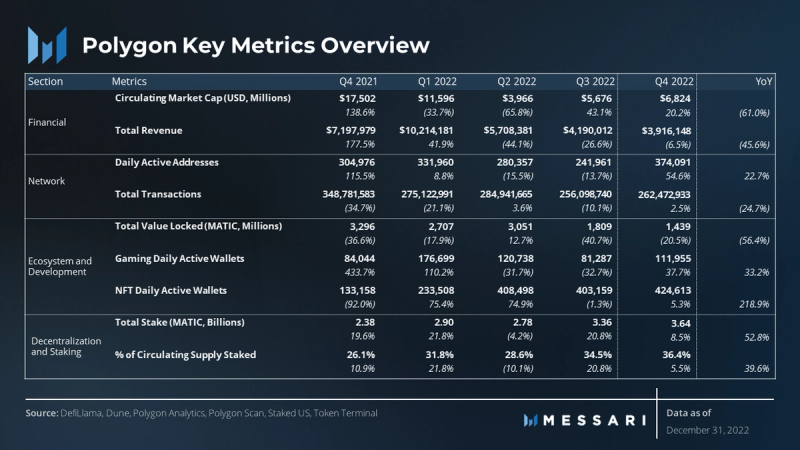
Performance Analysis
Today, the Polygon Proof-of-Stake (PoS) chain is responsible for nearly all of Polygon’s activity. The PoS chain is an Ethereum sidechain. Everything in the Performance Analysis section pertains to the PoS chain, unless otherwise specified.
Financial Overview
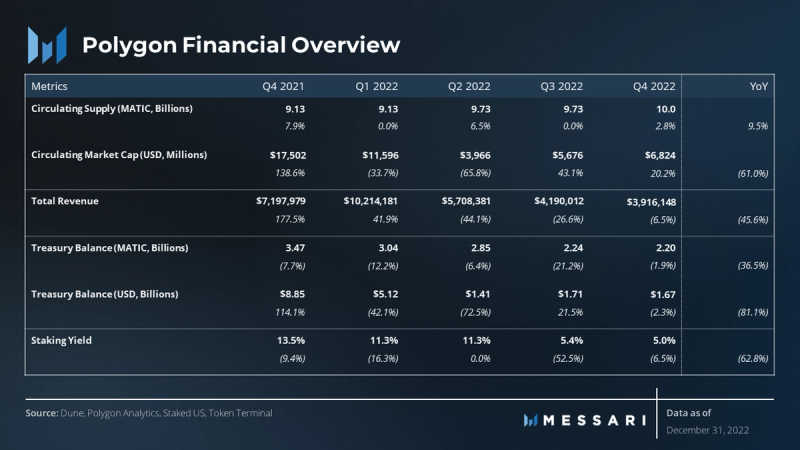
The fourth quarter was marked by the dramatic collapse of FTX, which stunned key players in the industry and garnered worldwide attention. Nevertheless, the crypto industry will endure and this event only underscores the importance of decentralized networks.
Despite the wider market turbulence, Polygon network finances held up well in the fourth quarter. Polygon’s circulating market capitalization rose by 20% quarter-over-quarter (QoQ), from $5.68 billion to $6.82 billion, placing it on average as the 10th largest protocol by market cap.
Polygon’s revenue remained relatively unchanged QoQ, and the treasury saw some increased expenditures. In October, the circulating supply of the MATIC token reached 10 billion.
Network Overview

While Polygon’s financial performance remained steady, its network key performance indicators saw impressive growth in the fourth quarter.
Daily active addresses and new addresses on the Polygon network saw substantial QoQ spikes of 55% and 34% respectively, with average daily active addresses reaching an all-time high. Transactions also saw a modest QoQ increase, up 3%. The increased activity was largely driven by the NFT and gaming sectors (more on this in the Ecosystem and Development section).
The Polygon PoS chain boasts quick block times, averaging about two seconds per block. In November, Polygon Labs researchers announced the Parallel EVM upgrade, aimed at doubling the speed of the Polygon PoS chain. No timeline for the mainnet implementation was released.
Ecosystem and Development

The fourth quarter saw a mixture of outcomes from the various sectors within the Polygon ecosystem.
The DeFi sector saw a drop in Total Value Locked (TVL) denominated in both USD and MATIC. Despite this decrease, the distribution of TVL within the Polygon ecosystem remains robust. The blue-chip protocols, Aave, Uniswap, and Lido, continue to lead their respective sectors. Despite the TVL decline, the quarter still saw several significant integrations, demonstrating the ongoing growth and development of the Polygon DeFi ecosystem.
The NFT sector continued to accelerate, reaching new highs in daily active wallets. The launch of Reddit collectible avatars in the previous quarter had further fueled the growth of the sector. Similar to Q3, the fourth quarter saw numerous new announcements, including partnerships between Polygon Labs and legacy tech giants, as well as NFT marketplaces and collections announcing their integration and migration to the network.
The gaming sector saw strong growth with daily active wallets and transactions increasing 38% and 36% QoQ, respectively. The success was largely driven by the continued growth of Polygon’s largest games. Moreover, there were several notable announcements including partnerships, grants programs, and game debuts.
DeFi
TVL
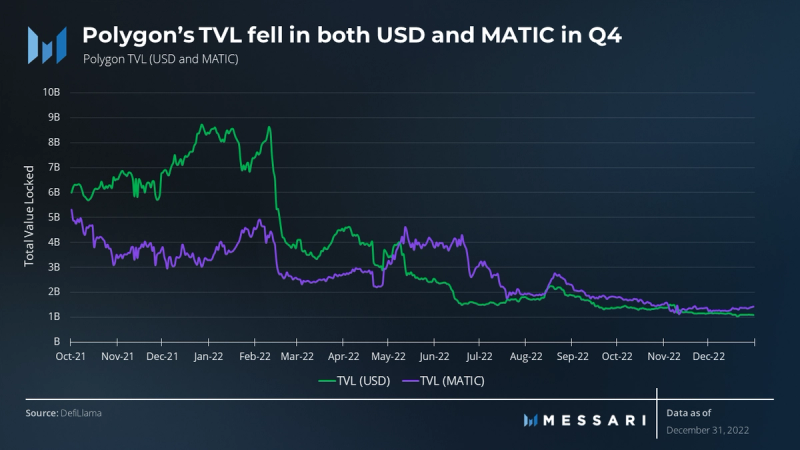

Polygon has seen a trend of decreasing TVL during the bear market of 2022. Despite this, the platform still ended the year with a TVL of around $1.1 billion (1.4 billion MATIC), ranking fifth amongst base layers. Polygon boasts a well-distributed TVL across its protocols, with Aave being the leader with 31% of the TVL ($340 million), followed by QuickSwap (15%; $160 million), Balancer (10%; $112 million), and Uniswap V3 (9%; $96 million).
DEXs
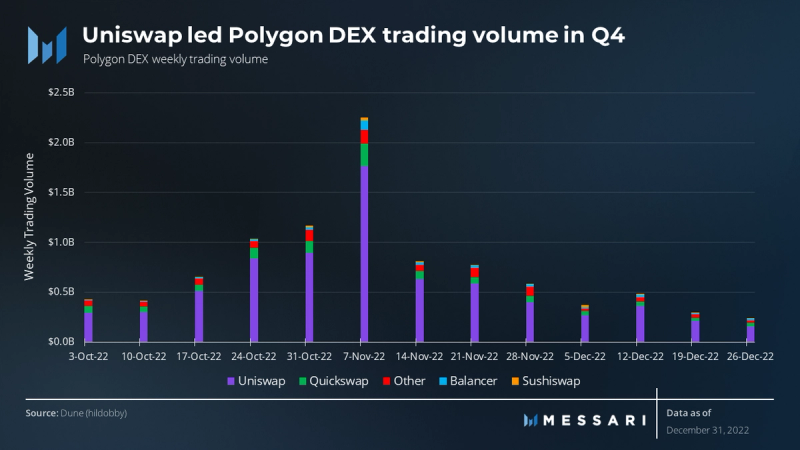
During Q4, Uniswap was the leading decentralized exchange (DEX) on Polygon with 76% of the total trading volume. QuickSwap was the runner-up, with 10% of the trading volume. Balancer and Sushi ranked third and fourth respectively. Prior to Uniswap’s rise, QuickSwap was the dominant DEX on Polygon in 2021. However, early in 2022, Uniswap launched on the Polygon mainnet and the two platforms engaged in a competition for DEX volume for a few months. Ultimately, Uniswap emerged as the leading DEX in 2022.
Liquid Staking
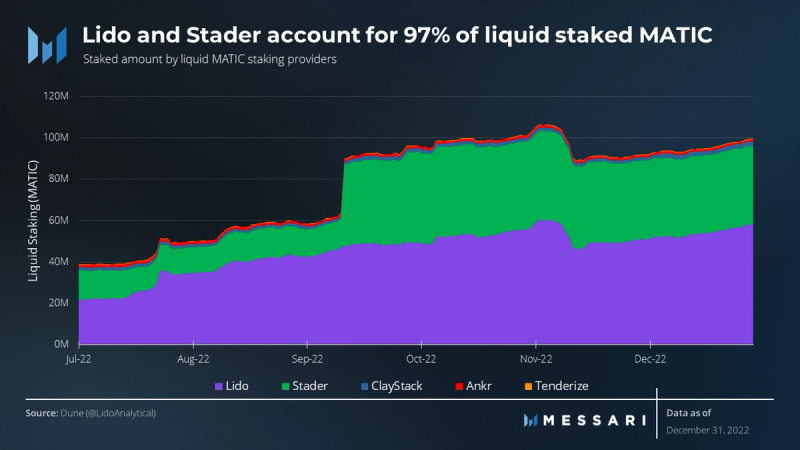
Overall, Polygon has a small percentage of liquid staked MATIC tokens. At the end of Q4, there were approximately 100 million MATIC liquid staked out of a total of 3.64 billion MATIC staked, representing about 3% of the total. Among the liquid staking providers, Lido is the market leader with 58% of the market share, followed by Stader with 38%. The two providers combined account for a significant 97% of liquid staked MATIC.
Stablecoins
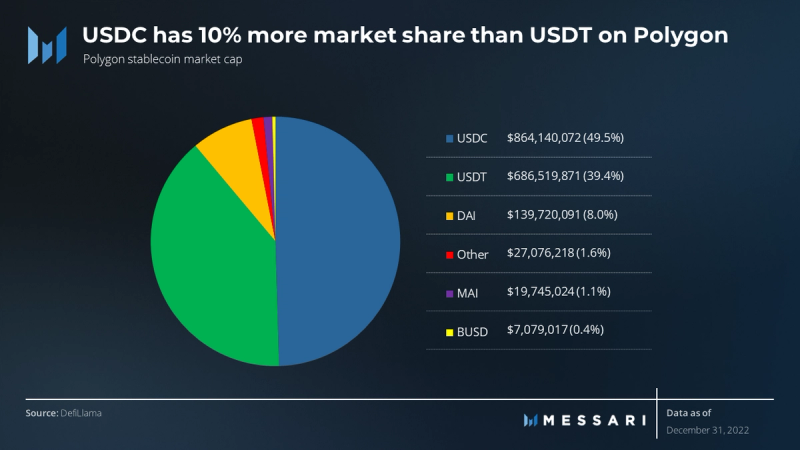
USDC and USDT, both of which are bridged, are the dominant stablecoins on Polygon. USDC leads the pack with 50% of the market share, followed by USDT with 39%. DAI rounds out the top three, accounting for 8% of the stablecoin market share.
Lens
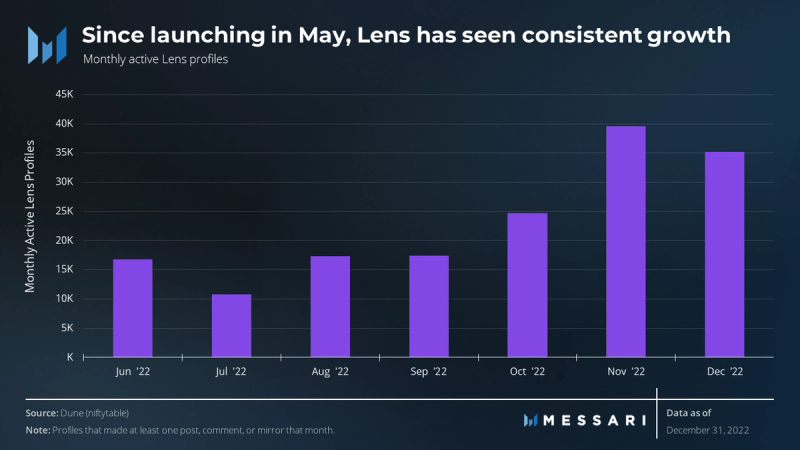
Lens is a decentralized social graph framework built on the Polygon PoS chain. It is designed to empower creators to own the links between themselves and their community, forming a fully composable, user-owned social graph.
Since its launch on Mainnet in May, Lens has seen a consistent increase in its user base. In the Q3, Lens recorded an average of 15,000 monthly active users, which significantly rose to 33,000 in Q4. It is important to note, Lens is still a walled garden and users must be whitelisted to join. To gain a more in-depth understanding of Lens’s growth, it is recommended to read the multiple reports that cover Lens in detail at Messari.
Integrations
The fourth quarter saw numerous significant integrations and launches in the Polygon DeFi ecosystem:
- BitPay declared support for Polygon and MATIC.
- Worldpay Global enabled the settlement of USDC for its clients on the PoS chain and also revealed its plan to become a Polygon validator.
- Coinbase Wallet debuted on the Polygon Mumbai Faucet, providing users with free testnet MATIC.
- The Binance stablecoin BUSD became available on Polygon.
- The Polygon Wallet Suite added Quest, a play-to-earn gamification feature.
- The Phantom Wallet was launched on Polygon.
- The Graph Protocol added Polygon support.
NFTs
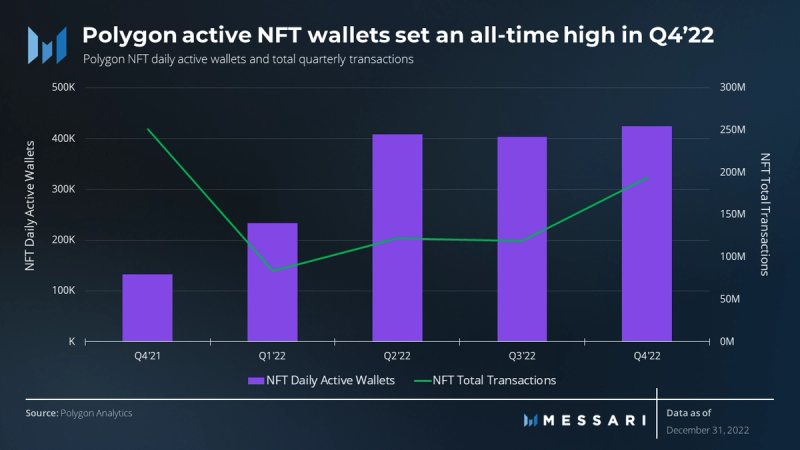

Polygon NFTs have proven to be a bright spot for the network during the bear market of 2022. The Polygon NFT market received a boost in the third quarter with the launch of Reddit’s NFT marketplace. The network’s popularity was further increased with new partnerships with major companies like Disney, Robinhood, and Starbucks, adding to the overall excitement and hype in the ecosystem.
In Q4, Polygon NFTs maintained their strong performance with a 5% QoQ rise in daily active wallets to a record high of 425,000 and a 63% QoQ increase in NFT transactions. Similar to the previous quarter, there were numerous important announcements made:
- Meta selected Polygon as Instagram’s NFT platform. Instagram users will soon be able to mint, showcase, and sell digital collections powered by NFTs on Polygon, giving creators a new way to engage with and monetize their fan communities. The first cohort of Instagram creators selling NFTs can be found here.
- Magic Eden revealed plans to integrate with Polygon, starting with a launchpad. Several games, including BORA by Kakao Games, IntellaX, Nay, Boomland, Block Games, Planet Mojo, and Taunt Battleworld, have committed to launching on the platform. Magic Eden’s Polygon Launchpad will be followed by a MATIC-compatible NFT marketplace.
- Y00ts, a popular NFT collection, announced it is migrating from Solana to Polygon.
Gaming
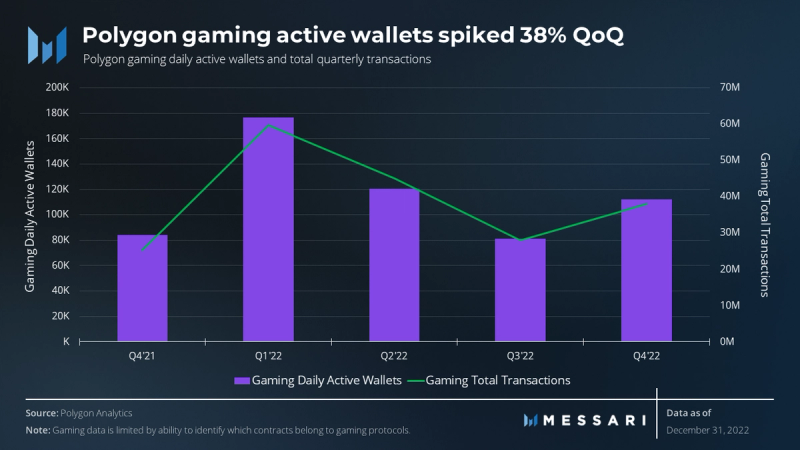
Polygon Gaming had an impressive Q4 as it saw a 38% QoQ spike in daily active wallets. This success is attributed to the continued success of Benji Bananas by Animoca Brands which was the top application by unique addresses in Q3, the steady growth of Planet IX since mid-November, and other games like Arc8 and Sunflower Land. In addition to its current lineup, Polygon has multiple new games in the works across various genres.
Additionally, there were several notable announcements in the gaming sector including:
- A partnership between ITSBLOC, a Web3 gaming platform, and Polygon Labs to create a new era of Play-to-Earn games. ITSBLOC intends to release games across various genres, such as MMORPGs and first-person shooter games.
- The popular Japanese comic book series, Captain Tsubasa, will make its cryptocurrency debut as a game on Polygon.
- Polygon Labs has joined forces with Earn Alliance, a Web3 gaming community and infrastructure platform.
- Polygon Labs is participating in Game7’s $100 million grants program for building better, sustainable, and open-source games as a collaborator. Game7 is a Web3 gaming DAO with a community-managed treasury.
Developer Activity

During Q4, Polygon was highly active in the development community. Polygon Labs conducted Polygon Connect Bogota and Polygon Web3: Made in India Tour, a tour across India composed of seven Polygon Guild events and the inaugural Polygon Connect: India. Polygon Labs signed a partnership with Reskill to work with 50 campuses across India to deliver Web3 education for budding engineers, and signed a partnership with Pesto Tech to help Web2 developers transition to Web3. Polygon Labs also became a global sponsor of Techstars Startup Weekend Global 2022, partnered with CV Labs to support the development of blockchain technology in Africa, sponsored the Moralis and Google Defining DeFi Hackathon, and participated in the Lisbon blockchain week 2022.
Polygon Lab’s relationship with the developer community is strengthened by its developer-focused products and initiatives, such as:
- Polygon Advocate Program — Empowering community members to educate others on building on the Polygon network. In 2022, over 7,000 developers participated in global workshops and training organized by Polygon Advocates. Polygon Labs plans to expand the program in 2023.
- Polygon Guilds — A platform for developers to organize monthly meetings, collaborate, conduct workshops, and more. Over 70 Polygon Guilds exist globally with plans to expand in 2023.
- Polygon University — A comprehensive learning platform for all things Polygon (currently in beta).
- Polygon Village — A full-stack developer ecosystem offering vouchers, grants, mentorship, a job board, and a bounty board.
- ZK Whiteboard Sessions — An educational series done in collaboration with ZK Hack teaching about zero knowledge.
The emphasis on developer engagement appears to be paying off as the 2022 Developer Report by Electric Capital recognized Polygon as a top developer ecosystem. Notable highlights include Polygon’s growth from 200 to over 1,000 developers since 2018, a 40% YoY increase in total developers with an average of 500+ monthly active developers in 2022, and its rapid growth to 150 full-time developers in under 4 years. The report ranked Polygon among leading developer ecosystems outside of Ethereum, alongside Solana, Cosmos, and Polkadot.
Decentralization and Staking
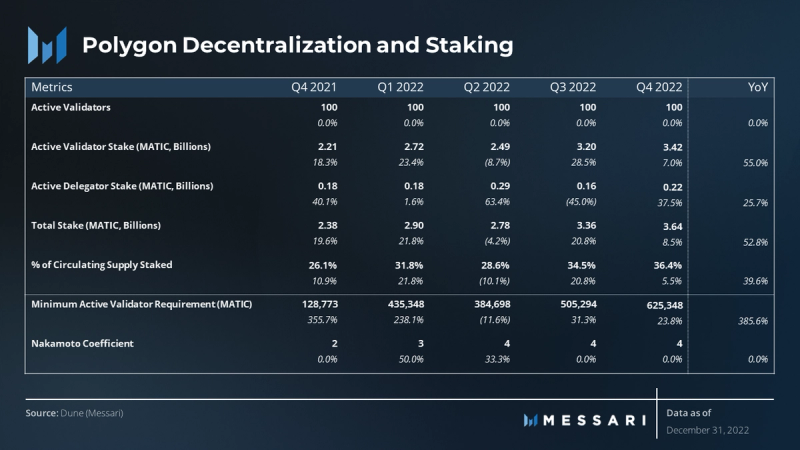
The Polygon PoS chain is composed of three layers: Ethereum, Bor, and Heimdall. The Ethereum layer holds the staking contracts for increased security. The Bor layer aggregates transactions into blocks and performs duties similar to the Ethereum Beacon Chain. The Heimdall layer transfers periodic checkpoints from Bor to the Ethereum Mainnet for finalization. Validators on the PoS chain run the Heimdall validator and Bor block producer nodes, and stake their MATIC in the MATIC staking contracts on Ethereum.
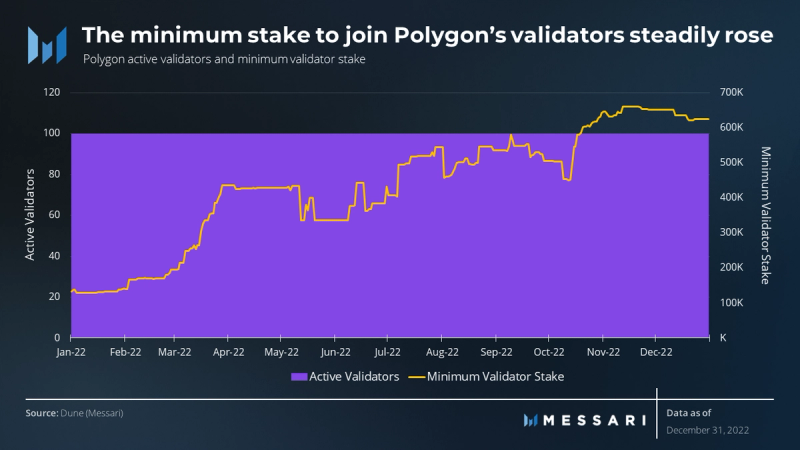
At present, the number of active validators is limited to 100. New validators can become active when a current active validator unbinds, however the cost of becoming an active validator has risen continually over the year. By the end of 2022, the minimum required stake for an active validator was 625,000 MATIC ($475,000), a 386% YoY increase from the previous year’s 129,000 MATIC. Polygon Improvement Proposal 4 proposes to increase the maximum validator set to 105.
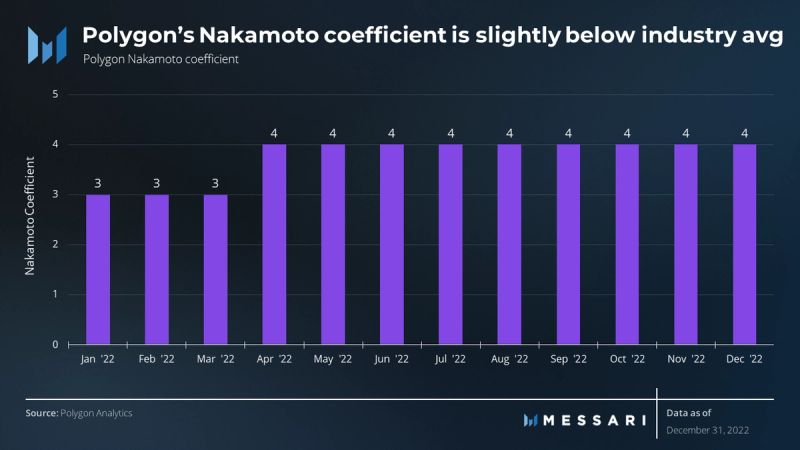
The active validators in Polygon have remained mostly unchanged since inception, resulting in minimal fluctuations in the Nakamoto coefficient. Polygon’s Nakamoto coefficient was three in Q1 2022, and four in the last three quarters of the year. Its overall Nakamoto coefficient is slightly lower than the industry average.
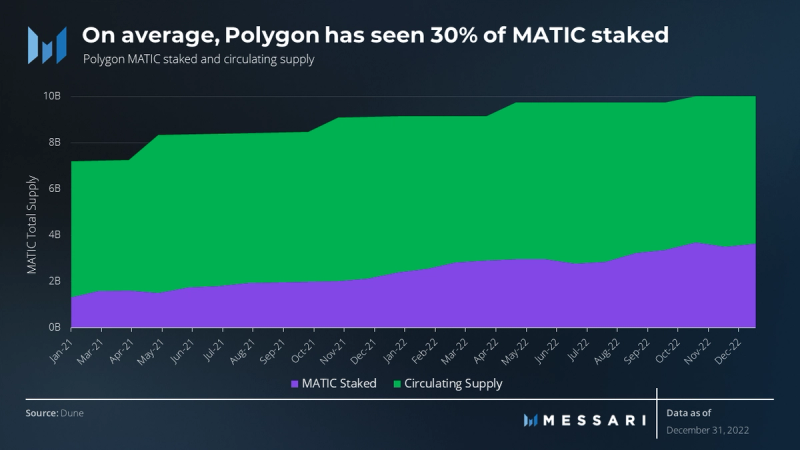
Polygon finished 2022 with 3.64 billion MATIC staked (36% of supply). In the past, Polygon’s staked supply has tended to remain relatively low, averaging around 30%. With the vesting of the total supply of MATIC, it will be interesting to see how this ratio evolves moving forward.
Qualitative Analysis
Sustainability
Polygon Labs unveiled the Polygon Green Manifesto in April, aimed at promoting sustainable growth and becoming carbon-negative. Along with the announcement, Polygon Labs pledged $20 million to support tech-driven initiatives to combat climate change. In September, Polygon Labs reinforced its commitment by stating it would use its core offerings to address waste, emissions, equity, supply, nature, and education.
In Q4, Polygon made progress towards its green goals by:
- Partnering with OCEEF, an ocean conservation exploration and education foundation, allowing the public to support their work by purchasing NFTs and using Polygon’s governance to democratize access to OCEEF’s research vessel.
- Senken unveiled plans to create the first blockchain-based marketplace for carbon credits for transparent and auditable climate action.
- Becoming a founding member of the Ethereum Climate Platform to encourage and finance projects that reduce GHG emissions and have a positive environmental and social impact.
- Joining a collaboration to offer a $1 million grant for creative climate solutions.
Polygon was also active across its other commitments:
- Nori partnered with Bayer Crops to improve carbon sequestration for farmers on the Polygon network.
- The National University of Mongolia introduced Meta University on Polygon, featuring NFTs for graduates.
- The International Road Federation and SettleMint launched a pilot project for a road safety platform on Polygon.
- Polygon Labs teamed up with Tether to help the city of Lugano become a blockchain-powered city.
Scaling Solutions

The Polygon Labs team is working hard to enhance Ethereum’s scalability by developing various solutions. The latest State of Polygon Q3 report provides an in-depth look at all Polygon scaling solutions. This report focuses specifically on two solutions that saw significant progress in Q4: Polygon Supernets and Polygon zkEVM.
Edge and Supernets
Polygon Edge is a modular blockchain development framework designed to support a variety of scaling and infrastructure solutions for developing Ethereum-compatible chains. Similar to Substrate (Polkadot) or the Cosmos SDK, Edge facilitates the development of application-specific chains. Polygon Supernets are powered by Polygon Edge and allow users to quickly setup a custom, high-performance blockchain network. Supernets solve common challenges developers face when building a blockchain.
During Q4, several exciting developments in the world of Supernets were announced. Nubank, a leading digital banking platform with support from industry giants Berkshire Hathaway and SoftBank, revealed plans to launch its own token on Polygon Supernets. Additionally, there was news of a partnership with Axelar aimed at improving cross-chain communication between different Supernets. Lastly, Uppolice made headlines by launching India’s first police complaint portal on the Supernets platform. As the Supernet fund is rolled out, expect the continued announcement of new Supernets.
zkEVM
Polygon Labs introduced Polygon zkEVM in July 2022, a Layer-2 scaling solution for Ethereum that uses zero-knowledge (ZK) proofs to enhance scalability while preserving Ethereum compatibility. In October, Polygon Labs announced the availability of Polygon zkEVM testnet, marking a significant milestone in the crypto industry as it was the first time a zkEVM testnet was made publicly available with an open-source ZK proving system, allowing anyone to review the code. This announcement was further boosted by the news that Aave, Uniswap, Lens, and Midnight Society, a gaming studio, would be joining the testnet.
To ensure the security of the zkEVM, Polygon commissioned a comprehensive, on-going audit by two firms. Shortly after the audit announcement, Polygon Labs launched the final testnet. The testnet introduced recursion, a technique that batches multiple ZK validity proofs into a single ZK validity proof, leading to significant improvements in throughput, latency, and prover efficiency. Overall, the zkEVM testnet has processed nearly 300,000 transactions, with 80,000 wallets, and an average block time of 48 seconds.
Vitalik’s zk-EVM framework classifies the Polygon zkEVM as a type-3 (close to being EVM equivalent) with the objective of becoming a type-2 (fully EVM equivalent). The challenge lies in balancing compatibility and performance. To tackle the performance aspect of the zkEVM, Polygon zkEVM employs Plonky2, a highly efficient zk proving system. The zkEVM mainnet is expected to launch in early 2023.
Closing Summary
The crypto industry faced significant challenges in 2021, but Polygon’s ecosystem managed to achieve impressive growth and progress.
During Q4, the NFT sector set a new record for daily active wallets. This growth was spurred by the introduction of Reddit collectible avatars in Q3, and the news that Polygon had been selected as Instagram’s NFT platform by Meta. Polygon’s list of esteemed partnerships now includes Disney, Meta, Nike, Reddit, and Starbucks.
Polygon’s gaming sector also had a strong Q4, thanks to the continued success of popular games like Benji Bananas, and the steady growth of other notable games like Arc8, Planet IX, and Sunflower land. The gaming sector’s overall growth is expected to continue in the coming months, as Polygon has multiple new games in development.
However, the DeFi sector of Polygon experienced slower growth relative to NFTs and gaming. During Q4, Polygon’s TVL in USD and MATIC decreased, and the overall trend for 2022 was negative. Nevertheless, Polygon’s DeFi ecosystem continued to be led by the most significant players, and several new integrations and announcements were made that will pave the way for further development.
Polygon has always prioritized developer-friendly practices and support, and Q4 was no exception. Polygon was highly active in the development community, hosting multiple tours, partnerships, and sponsorships. Polygon’s efforts were acknowledged by the prestigious Electric Capital Developer report, which recognized it as a top developer ecosystem that had grown from 200 to over 1,000 developers since 2018.
In addition to the PoS chain, Polygon is actively developing various Ethereum scaling solutions. During Q4, two of the most active solutions in terms of announcements and developments were Polygon zkEVM and Polygon Supernets. The latter announced the development of several new supernets and a partnership with Axelar aimed at improving communication between supernets. Concurrently, Polygon’s zkEVM testnet went live garnering attention throughout the industry as the first open-source zkEVM testnet. Over the course of Q4, the zkEVM testnet successfully processed nearly 300,000 transactions with 80,000 wallets. The zkEVM mainnet is currently scheduled for release on March 27, 2023.
Despite the difficulties faced in 2022, Polygon remained steadfast in its commitment to development and growth. The progress made during the bear market positions Polygon for a promising 2023. With the base-layer competition becoming increasingly competitive, expect Polygon to gain further momentum and continue its upward trajectory.

